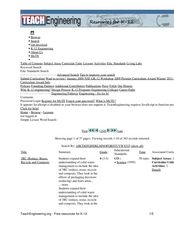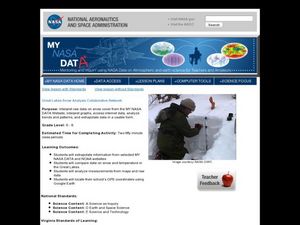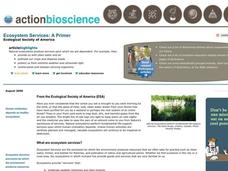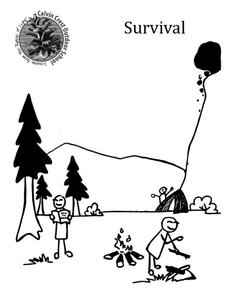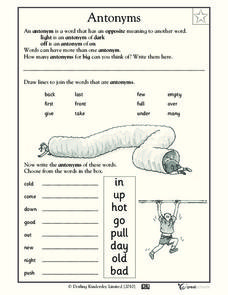Curated OER
Do Some Research: Science 6
In this science research activity, students read the sentence and use a library or the Internet to find the answer and write it on the blue line. Students must then write a report about this topic: two large bodies of air meet. The warm...
Curated OER
Sense of Touch
Students explore the sense of touch. They listen to and discuss the book, I Can Tell By Touching, observe a demonstration of cold, and create a touch book using candy buttons, pine needles, cotton, burlap, and wax paper.
Curated OER
Keeping Warm
Fifth graders measure the temperature of water using a thermometer. They record the temperatures of water on a chart. Students use the temperature data to determine which materials are the best conductors of heat. They discuss their...
Curated OER
Glacier Climbing
Students discuss glaciers and the current distribution of glaciers around the Earth. They create simulated glaciers using cornstarch, shoeboxes, water, and pebbles.
Curated OER
Meteorology Madness
Students probe the dynamic weather changes through several hands-0n activities in this seven lessons unit. The hydrologic cycle, clouds, atmosphere, air movement, fronts, and forecasting form the components presented in this unit.
Curated OER
Thar She Blows
Students discover the effects of El Nino on the global climate. As a class, they role play the role of a cold or warm wind and act out a skit in front of the class. They discuss the results of the role play once it is completed.
K12 Reader
Extreme Weather
Thunderstorms, tornados, blizzards, hurricanes. These extreme forms of weather are the focus of an article on a two-part reading comprehension worksheet. After reading the passage, kids use information in the text to respond to a series...
K12 Reader
Extreme Weather
What is thunder? After reading a short article about extreme weather, middle schoolers must use information in the text to explain this weather phenomenon.
Curated OER
Weather Maps and Prediction
Young meteorologists read basic weather maps by learning about the symbols that are associated with them. This two-day lesson plan has some excellent demonstrations and activities to get youngsters thinking about the weather in...
Curated OER
Weather
Students explore the earth's atmosphere, weather, and climate. They begin class with a discussion about weather patterns, atmosphere, and the layers of the earth. After the class discussion, students rotate through four stations to...
Curated OER
Great Lakes Snow Analysis Collaborative Network
Learners interpret data on snow cover and analyze trend patterns. In this snow lesson plan students compare data and locate their school's GPS coordinates.
Curated OER
Predicting Storms and Weather
Students use weather pattern worksheets to research how weather is predicted. In this weather prediction lesson plan, students predict the weather based on the wind, rain, currents, and other patterns.
Curated OER
Understanding Weather
In this science worksheet, middle schoolers examine the topic in order to solidify knowledge covered in the curriculum using puzzles and creative games.
Curated OER
How Much Is an Ecosystem Worth?
Students examine the value of ecosystems. They read and analyze an article, evaluate ecosystem services, research the benefits of biomonitors, and design a public service announcement.
Calvin Crest Outdoor School
Survival
Equip young campers with important survival knowledge with a set of engaging lessons. Teammates work together to complete three outdoor activities, which include building a shelter, starting a campfire, and finding directions in the...
Curated OER
Antonyms
Familiarize linguists with antonyms as they examine examples and match up opposites. First, scholars read a short description of antonyms, writing as many antonyms for big as they can. Then, they match up pairs of words that are antonyms...
Curated OER
Introduce Vocabulary: Over in the Meadow (Keats)
If you're reading the classic story Over in the Meadow, consider this strategy to cover vocabulary in context with budding readers. After a brief introduction, listeners raise a hand when they hear each word (bask,...
Read Works
How to Say “I Ruff You”
Who says you need a human to be your valentine on Valentine's Day? Give your dog-loving readers an inspiring perspective on how a sister givdes her brother a valentine from the family dog. They then answer 10 questions thatd involve...
Balanced Assessment
Multi-Graphs
So many things change as time goes by. Here, scholars create graphs based on this premise. Each problem asks pupils to sketch a graph that describes a given situation. Their graphs represent various characteristics such as height,...
American Museum of Natural History
What's This?: Early Humans
Early humans crafted shelters out of whatever materials they could find. A one-question quiz asks learners to identify the type of bones used to construct the hut pictured in a display.
Curated OER
Planning a Tourist Resort
Students work in teams of 2 to complete the presentation portion of the assignment. They may be required to work alone or may work with their partner to complete the "Board Member's Responses."
Curated OER
Make A Thunderstorm!
Students create a thunderstorm by putting ice cubes and food coloring into a container and observe what happens to the food coloring. In this thunderstorm lesson plan, students discuss the cause and effects of thunderstorms and then...
Curated OER
Clouds
In this science worksheet, students look for the meaning of the water cycle and its relation to the formation of clouds. They read the information about the different types of clouds.
Curated OER
Weather Maps and Prediction
Second graders point out symbols for high and low pressure that would be found on weather maps. They break into small groups and use a copy of the weather maps file to make observations about the maps and come up with an explanation of...





